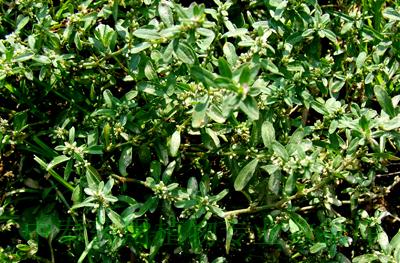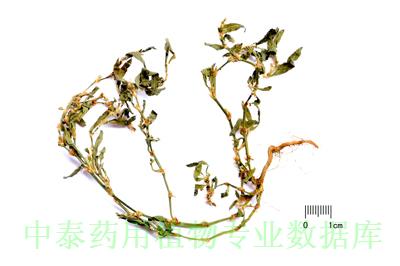| [English Name] | Common Knotweed Herb | |
| [Chinese Name] | 萹蓄 | |
| [Pinying Name] | Bianxu | |
| [Latin Name] | Polygoni Avicularis Herba | |
| [Genera] | Polygonaceae | |
| [Efficacy] | Damp-clearing drug | |
| [Pictures] | Plant picture | Drug picture |

|

|
|
| [Alias] | ||
| [Source] | ||
| [Plant morphology] | ||
| [Distribution] | ||
| [Gathering and processing] | ||
| [Characteristics] | ||
| [Ecology] | It grows in field and road side. | |
| [Chemical composition] | This plant contains flavonoid: avicularin, vitexin, quercitrin, luteolin, quercetin, isovitexin, rhamnetin-3-galactoside, hyperin[1]; coumarins: umbelliferone, scopoletin[1]; acidic component: sinapic acid, vanillic acid, ferulic acid, syringic acid, melilotic acid, p-coumaric acid, p-hydroxybenzoic acid, gentisic acid, caffeic acid, catechin, protocatechuic acid, ellgaic acid, p-hydroxyphenyl acetic acid, chlorogenic acid, salicylic acid, ellagic acid, oxalic acid, silicic acid[1]; saccharide: glucose, fructose, sucrose, water-soluble polysaccharide[1]; amino acids: methionine, proline, serine, threonine, tyrosine, phenylalanine, cystine, arginine, valine, glycine, leucine, lysine, isoleucine, tryptophan[1]. |
|
| [Pharmacological activities] |
1. Diuresis: Water extract show strong diuresis action on rat[1,2]. The activity compound may be its sylvine[3]. Avicularin show diuresis action on rat and dog when it used as intravenous injection[4]. 2. Lowering Blood Pressure: Armstrong extract show lowering blood pressure activity on cat, dog and rat model through noncompetitive inhibit angiotensin converting enzyme[4-6]. 3. Antibiosis: Armstrong can inhibit the growth of bacillus dysenteriae, ringworm fungus and microsporon lanosum[7-9]. 4. Other Effects: Armstrong still has raise breathing exercise, hemostasis with astringents, cholaneresis, potentiated carboxypeptidase activity[6,10]. Luteolin, Vitexin and its glycoside can inhibit human platelet aggregation[11]. |
|
| [Clinical trial] | ||
| [Properties] | ||
| [Medical and other Uses] | ||
| [Dosage] | ||
| [Cautions] | ||
| [Traditional usage] | ||
| [Toxicological studies] | ||
| [Pharmaceutical preparations] | ||
| [References] |
Pharmacologic Actions: [1] Haverland F. C A, 1964,61: [2] Huang Houpin, Cheng Caifen. Journal of [3] Lv Xianghua. Acta Pharmaceutica Sinica, 1966,13(6):454. [4] Li Yunshan, Fu Shaoxuan, Han Rui, et al. Acta Pharmaceutica Sinica, 1959,(01):1. [5] Aluf M A. C A, 1946,40:5844. [6] Inokuchi J. C A, 1985, 102:197701h. [7] The Clinic Internal Medicine Teaching and Research Group of Hunan Meidical University Journal of Central South University(Medical Sciences), 1959,(04):63. [8] Gao Jie. Chinese Journal of Postgraduates of Medicine, 1980,(7):18. [9] Zheng Wufei. National Medical Journal of China, 1952,38(4):315. [10] The new Jiangsu School of Medicine. Grand Dictionary of Chinese Medicine(the last volume, 1st edition), Shanghai: Shanghai Science & Technology Press, 1977:2329. [11] Pahosyan A . Khim-Farm Zh, 1986, 20(2) :190 (C A, 1986,104:199798k ). [12] Wan J M. Medicinal and Poisonous Plants of Southern and Eastern |
|